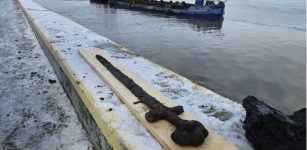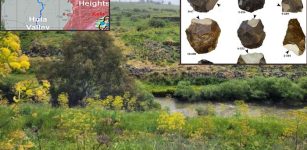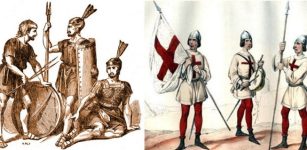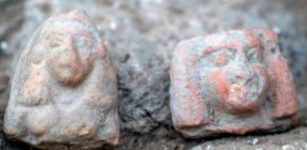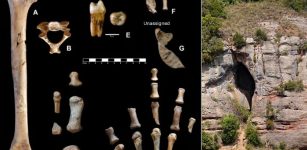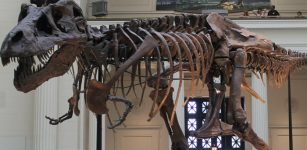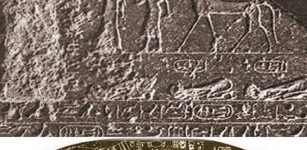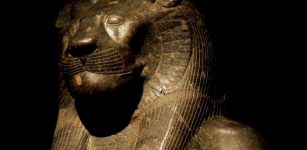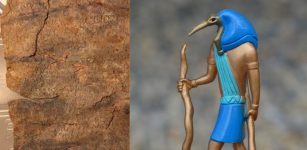5th-Century Tomb With Finds Of Historical And Artistic Value Discovered In Eastern Bohemia
Conny Waters - AncientPages.com - An ancient tomb located in the vicinity of Hradec Králové, a city in East Bohemia in the Czech Republic, was first unearthed in 2019.
It is an ancient burial from the end of the 5th century, historically connected to a turbulent time of the Migration Period or the Barbarian Invasions. From the Roman and Greek perspective, it was a period in the history of Europe, during and after the decline of the Western Roman Empire, during which there were invasions by peoples, notably the Germanic tribes, the Huns, the early Slavs, and the Pannonian Avars within or into the Roman Empire.
Image source: Archeologický ústav AV ČR / H. Březinová, R. Černochová
The period is traditionally taken to have begun in AD 375 (possibly as early as 300) and ended in 568.
The Migration Period was followed by the Age of Vikings.
Now for the first time, archaeologists have conducted an initial analysis of the tomb and found that especially the tomb of one woman has yielded finds of great historical and artistic value.
A team of experts across many disciplines has been working at the site outside the village of Sendražice for more than a year now. In total, they found the remains of six people, aged 16 to 55, all members of a German tribe, and no doubt, originally, the burial ground could contain elaborate grave goods, often of great value.
Unfortunately, the team was not the first to discover this burial mound, and it's not happened the first time. Over the centuries, countless precious grave sites and tombs have been robbed before archaeologists were able to examine them.
One grave of the woman believed to be a Langobard, a group of Germanic people who ruled most of the Italian Peninsula from 568 to 774, was not looted, Pavel Horník, an archaeologist with the Museum of Eastern Bohemia in Hradec Králové, told ČTK.
 Image source: Archeologický ústav AV ČR / H. Březinová, R. Černochová
Image source: Archeologický ústav AV ČR / H. Březinová, R. Černochová
In the grave were dozens of pieces of gold and silver jewelry, inlaid with semi-precious stones, such as almandines and garnets, headdress with gold flourishes. Among the finds from a woman's grave, four clasps of gold and silver inlaid with semi-precious stones stand out.
The headdress was decorated with decorated gold targets. The woman also carried glass beads, an iron knife, a bone comb, eggshells, and a ceramic vessel. It was placed in a log grave chamber together with a smaller animal. Large pieces of textiles and leather have been preserved on a pair of buckles placed in the area of the wedge, the archaeologist informed.
On the silver clasps clad with gold, the scientists proved the presence of at least two different textiles. One belonged to the garment that the buckles fastened, the other to the textile, which may have belonged to a coat or cloth that the woman had covered at the funeral.
"For their production, a linen and twill weave was used from threads with a diameter of 0.3 to 0.6 millimeters. Remains of leather or fur forming another part of the deceased's clothing were found on the buckles."
 Image source: Archeologický ústav AV ČR / H. Březinová, R. Černochová
Image source: Archeologický ústav AV ČR / H. Březinová, R. Černochová
The jewelry discovered there also had traces of at least two different textiles, one likely to fine clothing and the other part of a coat or ceremonial cloth used to cover her body, and some leather and fur.
According to Pavel Horník, the other graves were likely looted soon after the funerals. Some were damaged to the point where anthropological research is difficult to conduct, and in most cases, the sex of the deceased could not be determined.
Still, some items, including short swords and knives, glass and amber beads, metal belt components, and decorative shoe fittings, and bone combs were recovered. Samples were taken from a ceramic vessel, as well as DNA samples also revealed clues about the German tribe’s diet.
Anthropologists have found various diseases in the dead, such as damaging the joints, and traces of cancer in one individual's skull and pelvis. The investigation of the findings continues, for example, a more accurate chronological classification of the graves should be provided by radiocarbon dating of the remains.
Archaeologists in Sendražice also found a settlement from the Hallstatt period, a cremation grave isolated from the Eneolithic period with funnel-shaped cups, and the Middle Ages left a huge trough of unknown function and perhaps a well in the area.
Written by Conny Waters - AncientPages.com Staff Writer



